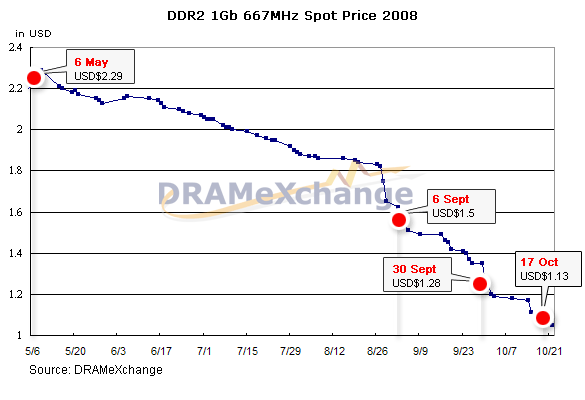Popular Keywords
- About Us
-
Research Report
Research Directory
Semiconductors
LED
Consumer Electronics
Emerging Technologies
- Selected Topics
- Membership
- Price Trends
- Press Center
- News
- Events
- AI Force
Taipei, October 22, 2008 --- DRAM DDR2 1Gb 667MHz spot price fell nearly 50% from a high of US$2.29 on May 6’th to US$1.13 on Oct. 17’th. On Sep.30th, price fell 7% in a single day from US$1.37 to US$1.28. DRAM spot price fell below US$1.5, the average cash cost of most DRAM makers back in Sep. 6’th. Given the current inventory level and weakening demand, DRAM makers will have to cut back production. Once DDR2 1Gb drops below US$1.3, continued production will lead to cash loss, and will be pointless to continue production.

According to DRAMeXchange, in September, the average inventory level of PC OEMs, memory module makers, and other buyers in the spot market can be as high as one month. As most buyers want to reduce instead of increasing inventory, it is impossible to sell all DRAM produced in September and October. Due to global recession and the already high DRAM content (2GB or more) per PC, DRAM makers have no alternative except to reduce DRAM production.
At present, there is a 10% or more over-supply in the DRAM market. Taking current inventory level into account, it will take at least 1 quarter to absorb all current inventory even if DRAM makers reduce production by 30%.If production is cut by 30% per quarter, but as soon as price stabilizes, and any major DRAM makers takes the shortcut and resumes full production, market will return to over-supply and price will drop again.
DRAMeXchange analyses points out that DRAM production must be cut by 20% or more for a prolonged period of more than 1 quarter, along with a slow production capacity increase and a delayed transition to 5xnm process, before we will see a return of balance between supply and demand. Only by then, DRAM price can again return to a level above DRAM makers’ total cost. We expect to see such adjustment happening soon although it will depend primarily on how soon DRAM makers can cut production, and it will be difficult to expect a return to profitability anytime soon.
A few key checkpoints for the next 3 to 6 months:
(1) once Micron confirms that it will acquire all current Qimonda shares in Inotera, Inotera will transfer its technology to Micron within 6 months and cease DRAM supply to Qimonda after 8 months. As such, we expect Inotera to reduce its capacity by roughly 20%, or 25k wafers/month, during the transition process in the next 6 months.
(2) After Qimonda sells off its stakes in Inotera, its production capacity - estimated at 100k 12” wafers/months - will come mainly from its own plants in Germany and USA in addition to Winbond – Qimonda’s contract production partner in Taiwan. How Qimonda re-adjusts its production capacity after it exits the Inotera venture will be a key measurement for how Qimonda will impact the market supply in the next 6 months.
(3) The 3 fabs at ProMOS - Fab2, 3, and 4 – also totaled up to 100k 12” wafers/month in capacity. Given its tight cash position, ProMOS will also need to re-adjust its production plan within the next few months as well.
Given the current average monthly wafer production of 1.24M, DRAMeXchange believes this figure needs to be reduced to at most 1M in order to reduce current inventory level. Given the slow growth in demand, DRAM supply growth will also need to slow to 30% or below in order to speed up the recovery in DRAM market.
Subject
Related Articles
Related Reports

